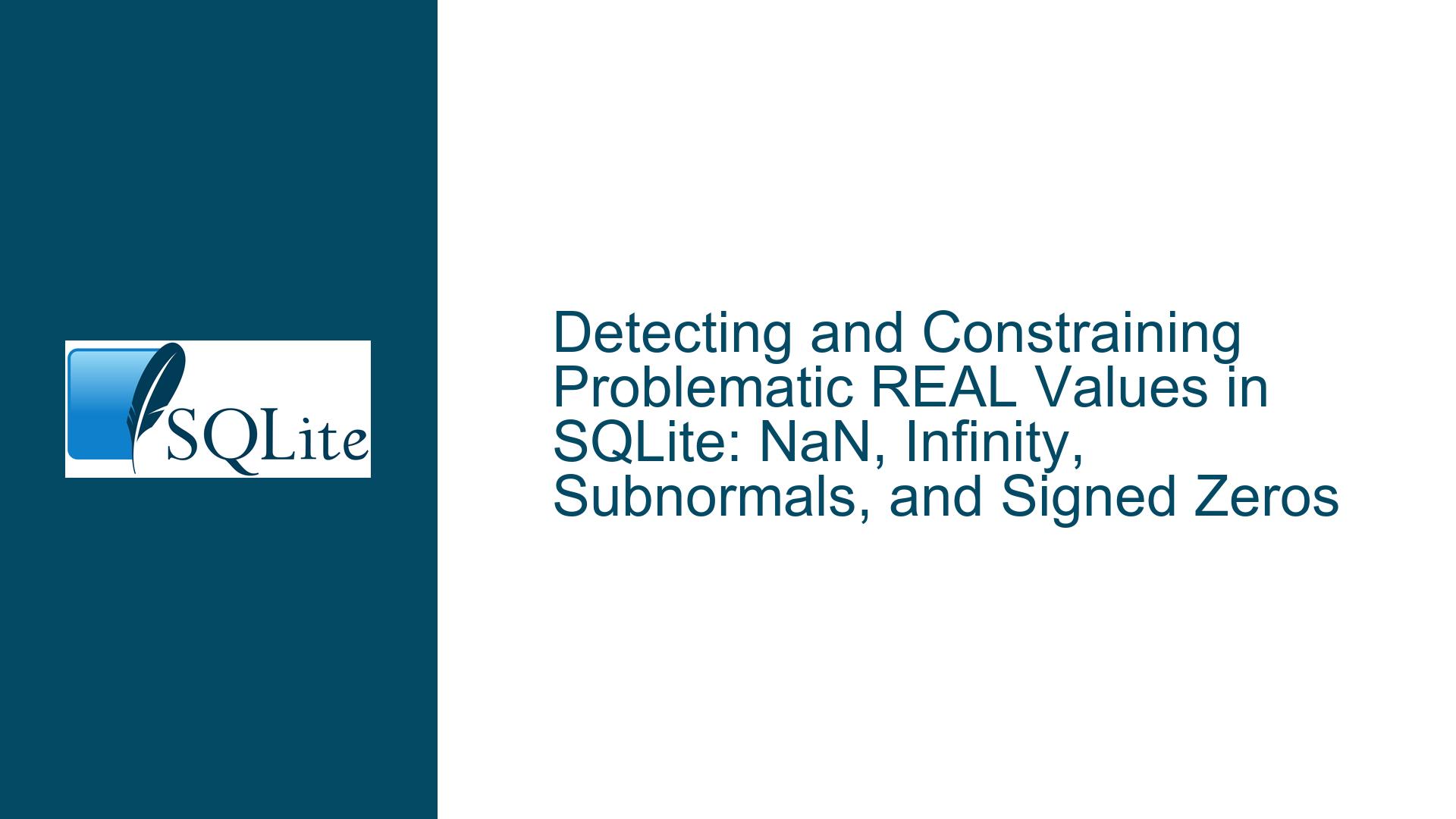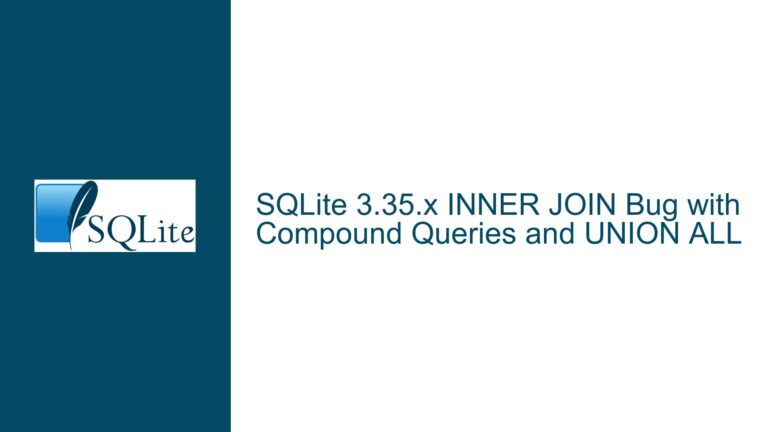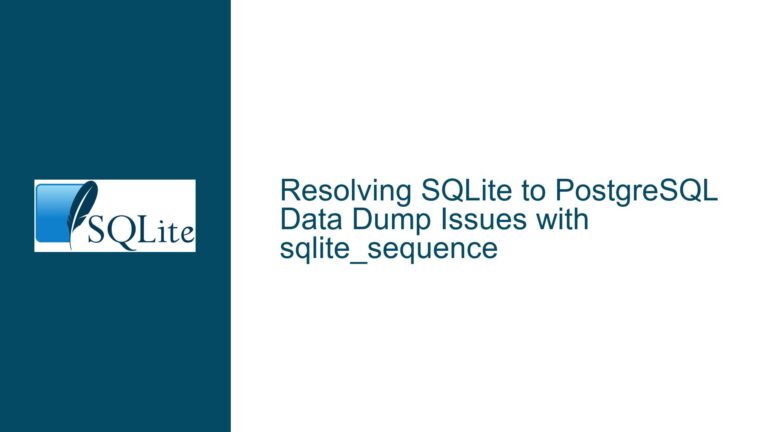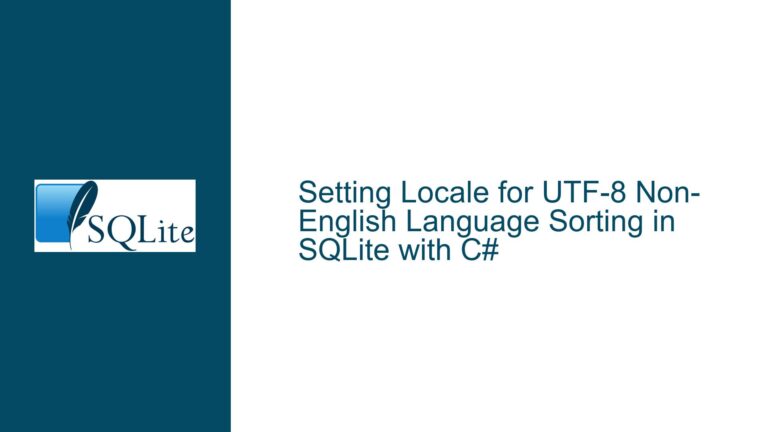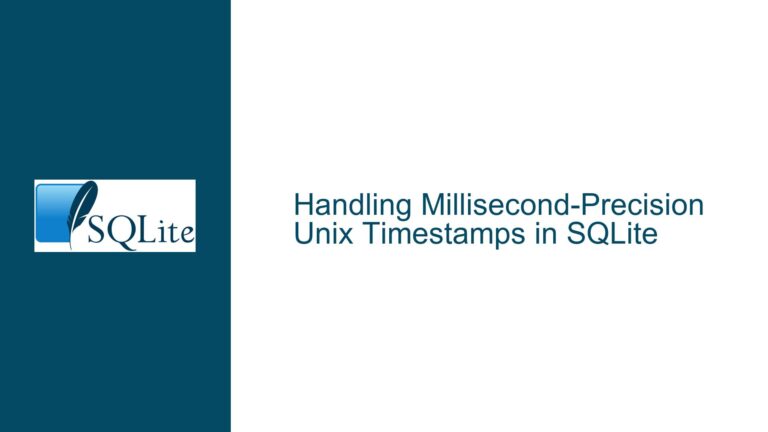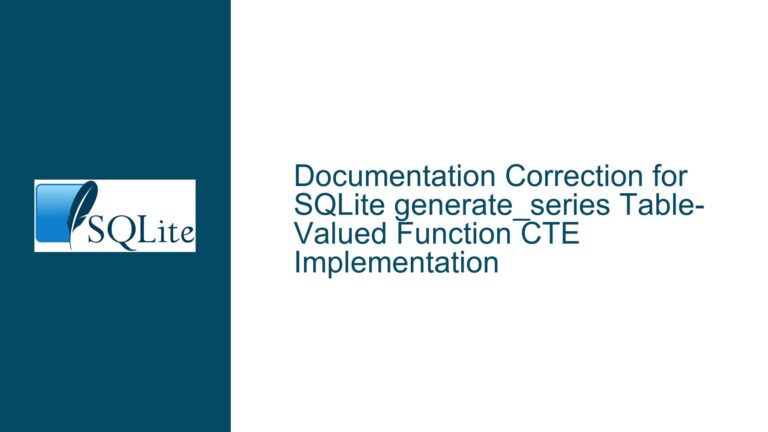Detecting and Constraining Problematic REAL Values in SQLite: NaN, Infinity, Subnormals, and Signed Zeros
Understanding REAL Value Constraints and Anomalies in SQLite
SQLite’s flexible type system and storage classes make it a powerful tool for handling diverse data types, including floating-point numbers. However, this flexibility introduces challenges when validating REAL column values for anomalies such as NaN (Not a Number), ±Infinity, subnormal numbers, -0.0, and other non-standard floating-point representations. These values often arise from mathematical operations (e.g., division by zero, underflow), data imports, or incorrect application logic. Left unchecked, they can corrupt analyses, destabilize calculations, or violate domain-specific constraints. This guide explores the root causes of these issues and provides actionable solutions for detecting and constraining such values in SQLite tables.
Root Causes of Invalid REAL Values in SQLite
1. Storage Class Flexibility and Type Affinity
SQLite uses dynamic typing, where values are assigned a storage class (INTEGER, REAL, TEXT, BLOB, NULL) regardless of column affinity. A column with REAL affinity will attempt to store values as floating-point numbers but does not inherently reject non-numeric values. For example:
- Inserting
'Infinity'or'NaN'as text may be converted to numeric values if possible. - Values exceeding the range of 64-bit IEEE 754 doubles (e.g., 1e309) are stored as
+Infinityor-Infinity. -0.0is distinct from+0.0in non-STRICTtables but coalesced inREAL-affinity columns due to type normalization.
2. Mathematical Operations and Edge Cases
Floating-point arithmetic can generate problematic values:
- Division by Zero:
1.0 / 0.0yields+Infinity;-1.0 / 0.0yields-Infinity. - Underflow: Results in subnormal numbers (values with magnitudes smaller than the smallest normal number,
≈2.225e-308). - Invalid Operations:
0.0 / 0.0orsqrt(-1.0)produceNaN, which SQLite represents asNULL.
3. Data Import and Application Logic Errors
External data sources (e.g., CSV files, JSON) may contain non-numeric literals like "Infinity" or "NaN". Without strict validation:
- Applications might insert these as
REALvalues. - Type conversions during bulk imports can silently introduce anomalies.
4. Limitations in SQLite’s Built-in Functions
SQLite lacks native functions to directly classify floating-point values. While ieee754() decomposes numbers into significand and exponent components, distinguishing edge cases requires explicit checks.
Strategies for Detecting and Constraining Invalid REAL Values
1. Using CHECK Constraints and Type Enforcement
For basic validation, combine CHECK constraints with SQLite’s typeof() and value comparisons.
Example: Blocking ±Infinity in STRICT Tables
CREATE TABLE measurements (
value REAL NOT NULL CHECK (
value != 1e999 AND
value != -1e999 AND
abs(value) >= 2.2250738585072014e-308 -- Block subnormals
)
) STRICT;
Key Notes:
1e999and-1e999represent ±Infinity in SQLite.STRICTtables enforce column types, rejecting non-REALvalues.- Subnormals are blocked by checking the magnitude against the minimum normal value.
Handling -0.0 in Non-STRICT Tables
In non-STRICT tables, use ieee754() to distinguish -0.0:
SELECT
x,
ieee754(x) = 'ieee754(1,-3071)' AS is_negative_zero
FROM data;
2. Decomposing Values with the ieee754 Function
The ieee754(x) function returns a string describing the significand and exponent of x. Use this to classify values:
SELECT
x,
CASE
WHEN x = 1e999 THEN '+Infinity'
WHEN x = -1e999 THEN '-Infinity'
WHEN ieee754(x) = 'ieee754(1,-3071)' THEN '-0.0'
WHEN ieee754_exponent(x) <= -1023 THEN 'Subnormal'
ELSE 'Normal'
END AS classification
FROM data;
Components of ieee754() Output:
- Significand (M): A signed integer representing the mantissa.
- Exponent (E): Adjusted to avoid negative values (bias = 1075).
- Subnormals: Exponent ≤ -1023 (E ≤ 52 after bias adjustment).
3. Custom SQL Functions for Advanced Classification
For granular control, create user-defined functions (UDFs) using SQLite’s C API. The provided extension (from the discussion) adds functions like isInfinity(x), isDenormal(x), and isNZero(x):
Compiling and Loading the Extension
- Save the C code as
sqlite_math.c. - Compile with:
gcc -g -fPIC -shared sqlite_math.c -o sqlite_math.so -lm - Load in SQLite:
.load ./sqlite_math
Example Queries with UDFs
-- Check for subnormal values
SELECT x FROM data WHERE isDenormal(x);
-- Classify all values
SELECT
x,
fpclassify(x) AS class,
isInfinity(x) AS is_inf,
isNZero(x) AS is_neg_zero
FROM data;
Function Reference:
fpclassify(x): Returns an integer representing the IEEE 754 class.isDenormal(x): 1 ifxis subnormal.isInfinity(x): 1 for ±Infinity.isNZero(x): 1 for-0.0.
4. Handling NULLs and Type Conversions
- NaN Handling: SQLite represents NaN as
NULL. UseIS NULLto detect NaNs, but ensure columns are nullable only if valid. - Strict vs. Non-Strict Tables:
STRICTtables reject invalid types (e.g., text ‘NaN’) but do not block ±Infinity or subnormals.- Non-
STRICTtables may coerce values, losing type fidelity (e.g., converting-0.0to0.0inREALcolumns).
5. Data Validation Workflows
Implement pre-insertion checks in application code or triggers:
Trigger-Based Validation
CREATE TRIGGER validate_real BEFORE INSERT ON measurements
BEGIN
SELECT
CASE
WHEN NEW.value = 1e999 OR NEW.value = -1e999 THEN
RAISE(ABORT, 'Infinity not allowed')
WHEN abs(NEW.value) < 2.2250738585072014e-308 THEN
RAISE(ABORT, 'Subnormal not allowed')
WHEN ieee754(NEW.value) = 'ieee754(1,-3071)' THEN
RAISE(ABORT, '-0.0 not allowed')
END;
END;
6. Testing and Edge Case Verification
Populate test tables with edge cases to validate constraints:
INSERT INTO measurements (value) VALUES
(0.0), -- Valid
(-1e999), -- Fails: -Infinity
(1e-309), -- Fails: Subnormal
(1e999); -- Fails: +Infinity
Summary of Best Practices
- Use STRICT Tables: Enforce column types and prevent type coercion.
- Combine CHECK Constraints and IEEE 754 Checks: Block infinity, subnormals, and -0.0.
- Extend SQLite with Custom Functions: For detailed classification without application-side logic.
- Validate Data at Multiple Layers: Application code, triggers, and constraints.
- Test Extensively: Verify constraints with known edge cases before deployment.
By understanding SQLite’s handling of floating-point values and leveraging its extensibility, developers can enforce robust data integrity rules for REAL columns, mitigating risks from anomalous values.
